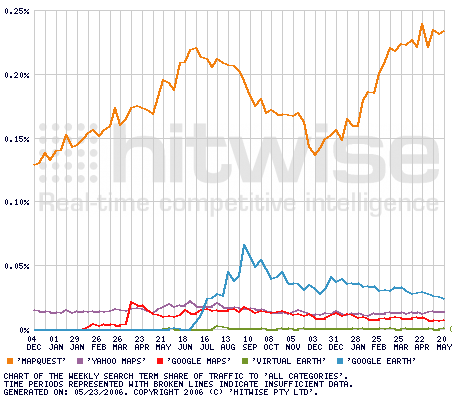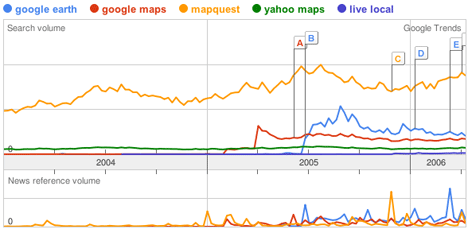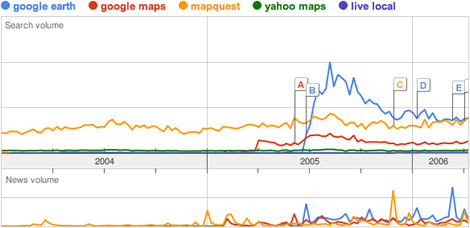Last weekend, Hitwise’s global research general manager Bill Tancer hit upon the idea that search term popularity for mapping services might be a good proxy for mindshare. This follows a much remarked-on post of his on Friday where he looked at mapping site popularity from the perspective of “internet visits”, though that data was of US surfers only (something which was left unmentioned by most re-reporting — I originally assumed it was global data too, until I read Bill’s clarification in his comments). I blogged that post, and tried to leave some comments, but only the first one made it past moderation, so here goes with some more questions about the metrics:
Hitwise gets its data via an ISP affiliate program, so that it has access to ISP customers’ web surfing logs. This info includes “a range of industry standard metrics relating to the viewing of websites including page requests, visits and average visit length,” according to this page about their methodology. I don’t see how such data can capture Google Earth usage, so I’m pretty sure that Google Earth’s 2% share of mapping site usage that Hitwise reports only refers to visits to the Google Earth website, where all you can do is download the application.
But this incongruity between new internet uses and old metrics also extends to AJAX-based services. Specifically, using the APIs of web services like Google Maps, Yahoo! Maps, Microsoft Live Local and MapQuest (free since March 2006) to make mashups on your own domain is not something the traditional accounting model for usage stats captures. Since Google Maps is the first and overwhelmingly popular choice for mashup makers, the Google logo has been in front of far more eyeballs than Hitwise’s numbers suggest.
Hitwise’s mindshare chart for these mapping services is interesting in another way: It allows us to compare Hitwise data to Google’s own. Notice how with Hitwise’s US data, Mapquest has a very large mind share, compared to others:
(Source)
This correlates well with Google Trends’ own mindshare chart for US users:
More relevant, however, is Google Trends’ global mindshare chart for maps, which I made a few weeks ago when Google Trends first came out. it shows Mapquest running neck-and-neck with Google Earth:
What does this tell us? That MapQuest’s brand awareness is largely a US phenomenon — probably because MapQuest has traditionally been weak in non-US maps.
In addition, now that we know that Hitwise’s dataset is US-only, I suspect Google’s position in search vs. Yahoo! and MSN is even stronger globally, because Google’s localization efforts are far more advanced than the competition’s. Still, I think the overall global market share for the big three search engines is lower than Hitwise’s US numbers, simply because of the existence of local services, like China’s Baidu.



Like it, like it.
Frankly, I’m wondering when Google is going to come out with a paid version of Trends for marketers?
http://www.sparkplug9.com/bizhack/index.php/2006/05/25/google-trends-theres-a-pay-model-here/